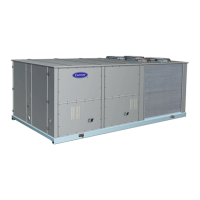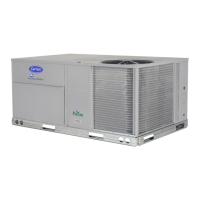10
PURON
®
(R-410A) REFRIGERANT
This unit is designed for use with Puron (R-410A) refrigerant. Do
not use any other refrigerant in this system. Puron (R-410A) re-
frigerant is provided in pink (rose) colored cylinders.
These cylinders are available with and without dip tubes; cylinders
with dip tubes will have a label indicating this feature. For a cylin-
der with a dip tube, place the cylinder in the upright position (ac-
cess valve at the top) when removing liquid refrigerant for
charging. For a cylinder without a dip tube, invert the cylinder (ac-
cess valve on the bottom) when removing liquid refrigerant.
Because Puron (R-410A) refrigerant is a blend, it is strongly rec-
ommended that refrigerant always be removed from the cylinder
as a liquid. Admit liquid refrigerant into the system in the dis-
charge line. If adding refrigerant into the suction line, use a com-
mercial metering/expansion device at the gage manifold; remove
liquid from the cylinder, pass it through the metering device at the
gage set and then pass it into the suction line as a vapor. Do not re-
move Puron (R-410A) refrigerant from the cylinder as a vapor.
Refrigerant Charge
Amount of refrigerant charge is listed on the unit’s nameplate. Re-
fer to Carrier GTAC2-5 Charging, Recovery, Recycling and Rec-
lamation training manual and the following procedures.
Unit panels must be in place when unit is operating during the
charging procedure.
NO CHARGE
Use standard evacuating techniques. After evacuating system,
weigh in the specified amount of refrigerant.
LOW-CHARGE COOLING
Using cooling charging charts (see Fig. 13-15), vary refrigerant
until the conditions of the appropriate chart are met. Note the
charging charts are different from type normally used. Charts are
based on charging the units to the correct subcooling for the vari-
ous operating conditions. Accurate pressure gage and temperature
sensing device are required. Connect the pressure gage to the ser-
vice port on the liquid line. Mount the temperature sensing device
on the liquid line and insulate it so that outdoor ambient tempera-
ture does not affect the reading. Indoor-air cfm must be within the
normal operating range of the unit.
TO USE COOLING CHARGING CHARTS
Take the outdoor ambient temperature and read the liquid pressure
gage. Refer to chart to determine what liquid temperature should
be. If liquid temperature is low, add refrigerant. If liquid tempera-
ture is high, carefully recover some of the charge. Recheck the liq-
uid pressure as charge is adjusted.
EXAMPLE:
Model 48LC*004
Outdoor Temperature. . . . . . . . . . . . . . . . . . . . . . . . . . 85°F (29°C)
Suction Pressure. . . . . . . . . . . . . . . . . . . . . . . . .140 psig (965 kPa)
Suction Temperature should be . . . . . . . . . . . . . . . . . . 60°F (16°C)

